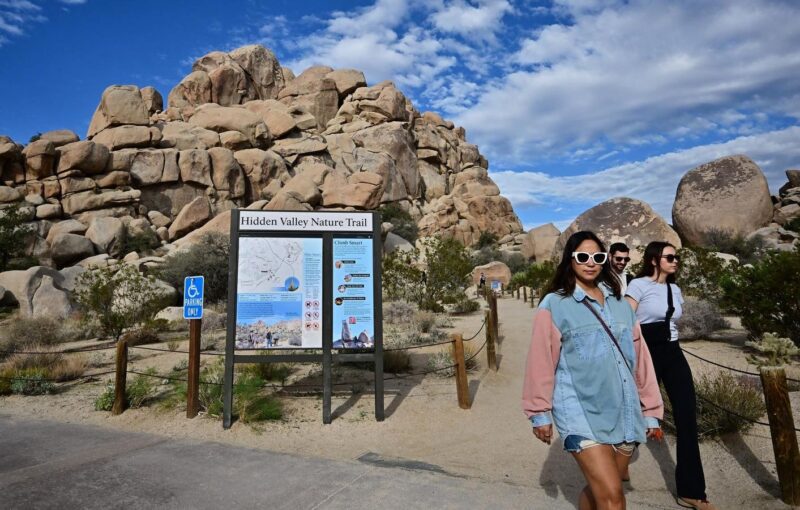People exit the Hidden Valley Nature Trail at Joshua Tree National Park in California, on October 10, 2025, on the tenth day of the federal government shutdown. The US national park in southeastern California, located in both the Mojave and Colorado deserts, has remained open and accessible since the shutdown began. Some visitor services are limited or closed, with entrance fees not collected as a limited staff of maintenance personnel remain on duty. (Photo by Frederic J. BROWN / AFP) (Photo by FREDERIC J. BROWN/AFP via Getty Images)
AFP via Getty Images
The 2025 government shutdown reaches Day 21 as you read this. The environmental effects on national parks and public lands are growing. Most gates and roads remain open, but routine stewardship is paused or sharply reduced. After three weeks without normal staffing, parks and forests are seeing more litter, trail wear, wildlife exposure to human food, and scattered resource damage. These impacts carry immediate ecological costs and longer term economic costs for agencies and gateway communities.
Under the Interior Department’s lapse plan, visitor centers, restrooms, most staffed campgrounds, and many maintenance functions are closed while essential law enforcement continues at reduced levels. The policy keeps basic access while limiting services and monitoring. Several advocacy groups warn that this arrangement exposes sensitive habitats to preventable harm. The National Parks Conservation Association (NPCA) writes that a shutdown can leave parks “open and unprotected,” which increases risks to natural and cultural resources when staff are furloughed.
Environmental And Staffing Strains Show In Parks
On high demand corridors, the tradeoffs are visible. Skyline Drive in Virginia’s Shenandoah National Park remains open during peak foliage. Fees are not collected, and updates can be limited. Local reporting describes heavy traffic, overflow parking, and crowding at overlooks as leaf peepers arrive during good weather windows. The Appalachian Trail Conservancy (ATC) also notes that the trail remains accessible, but services are reduced. Hikers should expect closed facilities and minimal updates from federal channels while the lapse continues.
Trash is seen strewn along the road at Joshua Tree National Park in California, on October 10, 2025, on the tenth day of the federal government shutdown. The US national park in southeastern California, located in both the Mojave and Colorado deserts, has remained open and accessible since the shutdown began. Some visitor services are limited or closed, with entrance fees not collected as a limited staff of maintenance personnel remain on duty. (Photo by Frederic J. BROWN / AFP) (Photo by FREDERIC J. BROWN/AFP via Getty Images)
AFP via Getty Images
Trash and human food waste are early drivers of environmental stress when collection pauses. Overflowing cans and informal dumping attract wildlife and shift behavior. Bears enter hyperphagia in autumn and seek high calorie foods. When they find unsecured human food or trash, animals can become food conditioned and more likely to approach people. That pattern increases future management actions that can end poorly for wildlife. NPCA’s Government Affairs team warns that the absence of routine waste management and on-site education can have “immediate ecological consequences” for wildlife and visitor safety.
Trails and recreation infrastructure begin to deteriorate when routine tasks stop. Drainage clogs after storms. Washouts expand. Downed trees push hikers into vegetation and social trails. Volunteer clubs often manage this backlog with agency partners, but they depend on access, coordination, and materials that are limited during a shutdown. The Outdoor Alliance explains that public lands may remain open while being largely unstaffed, which accelerates wear on trails and facilities and raises the cost of repair once funding resumes.
An Extended Shutdown Will Harm Ecosystems And Local Economies
Enforcement capacity is also lower after three weeks. Rangers deter illegal off-roading, unauthorized fires, and resource vandalism. When staffing is thin, incidents are harder to prevent and slower to address. Prior shutdowns saw spikes in prohibited activity at some sites, which later required specialized restoration and higher costs. Analyses from advocacy groups and recent coverage of this shutdown describe similar concerns today, including heavier crowds at sites that lack basic services or real-time conditions updates.
The economy of outdoor communities reflects these environmental pressures. Fee revenue supports trail repairs and habitat work, but it declines during a shutdown. Visitor spending in rural towns drops as trips are canceled or shortened, which affects small businesses that often contribute volunteer time or direct donations to stewardship projects. NPCA and industry groups warn that the longer the lapse lasts, the more expensive recovery becomes because damage accumulates and seasonal work windows close.
Two messages from partners stand out after three weeks. First, NPCA urges caution about unmanaged access. “Shutdowns leave national parks open and unprotected,” the group writes, highlighting the gap between open gates and reduced staffing for resource protection. Second, the Appalachian Trail Conservancy asks visitors to adjust behavior until normal operations return. “It is critical that all visitors practice Leave No Trace,” the ATC advises, noting that many services are curtailed.
After 21 days without maintenance or monitoring, even small impacts can aggregate into larger problems. Off trail trampling near overlooks, roadside vegetation damage at informal pullouts, and food waste around trailheads can require seasonal or multi year restoration once the shutdown ends.
Visitors can help reduce the curve of damage while access remains. Pack out all trash. Store food securely. Stay on established trails and use legal pullouts. Choose state parks or locally managed sites when federal services are minimal. Expect slower emergency response and plan conservative routes. For Skyline Drive, rely on state or nonprofit channels for updates on crowds or temporary closures, since some federal pages may not reflect current conditions during the lapse.
The shutdown has turned peak fall into a stress test for public lands. Many sites remain physically open, but the combination of high visitation and reduced services shifts environmental and financial costs into the future. Restoration will require time, staffing, and money once operations resume. For now, the most reliable tools are restraint by visitors and clear communication from nonprofits and state partners that continue to share conditions and safety information during the federal funding lapse.









